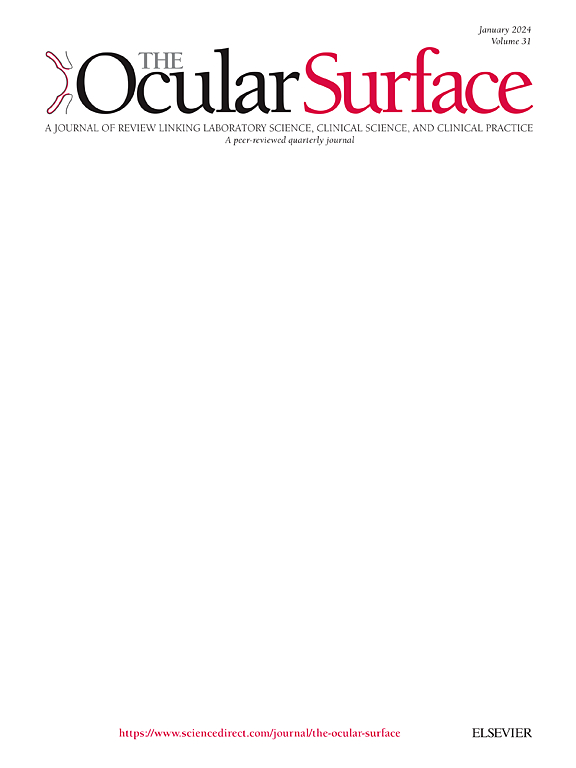一项大型无假设蛋白质组学研究调查血清炎症标志物作为干眼病的生物标志物。
IF 5.6
1区 医学
Q1 OPHTHALMOLOGY
引用次数: 0
摘要
目的:在以人群为基础的队列中,使用无假设的蛋白质组学方法测试血清炎症标志物与干眼病(DED)之间的关系。方法:对来自TwinsUK队列的2602名未选择的社区参与者(平均年龄61.5岁(21-92岁),94.4%为女性)进行了检查。采用经验证的妇女健康研究(WHS)问卷对DED进行评估;病例由以前的临床医生诊断或存在高度症状性干眼症来定义。用Olink Target 96炎症指标评估血清炎症标志物。我们进行了逻辑回归混合效应模型,调整了年龄、BMI、性别和双胞胎相关性,并校正了错误发现率(FDR)。结果:whs定义的DED患病率为29.1%,其中26.2%既往诊断为DED, 16.5%有高度症状性干眼。在74个炎症标志物中,发现神经营养因子-3 (NT-3;OR: 0.68, FDR p值:0.043),自然杀伤细胞受体2B4 (CD244;OR: 0.68, FDR p值:0.043),C-X-C motif趋化因子(CXCL) 9 (OR: 1.23, FDR p值:0.043)和CXCL10 (OR: 1.22, FDR p值:0.043)。发现CCL19、CXCL9、CXCL10、CCL20、CX3CL1 (fractalkine)、TNF、CDCP1和CCL25水平升高与高度干眼症有显著相关性。结论:这项基于人群的大型研究发现几种血清炎症蛋白与DED相关,证实并补充了先前在小鼠模型和临床病例对照研究中进行的靶向泪液、角膜和结膜表达研究。有趣的是,一种新的潜在生物标志物NT-3在角膜神经功能中起作用,被发现。本文章由计算机程序翻译,如有差异,请以英文原文为准。
A large hypothesis-free proteomics study investigating serum inflammatory markers as biomarkers of dry eye disease
Purpose
To test the association between serum inflammatory markers and dry eye disease (DED) using a hypothesis-free proteomic approach in a population-based cohort.
Methods
A total of 2602 unselected community-based participants (mean age 61.5 (range 21–92 years), 94.4 % female) from the TwinsUK cohort were examined. DED was assessed with the validated Women’s Health Study (WHS) questionnaire; cases were defined by either a previous clinician diagnosis or presence of highly symptomatic dry eye. Serum inflammatory markers were assessed with the Olink Target 96 Inflammation panel. We performed logistic regression mixed effect models, adjusted for age, BMI, sex, and twin relatedness, with false discovery rate (FDR) correction.
Results
Prevalence of WHS-defined DED was 29.1 %, with 26.2 % having a previous diagnosis of DED and 16.5 % having highly symptomatic dry eye. Of 74 inflammatory markers, significant associations with WHS-defined DED were found for neurotrophin-3 (NT-3; OR: 0.68, FDR p-value: 0.043), natural killer-cell receptor 2B4 (CD244; OR: 0.68, FDR p-value: 0.043), C-X-C motif chemokines (CXCL) 9 (OR: 1.23, FDR p-value: 0.043) and CXCL10 (OR: 1.22, FDR p-value: 0.043). Significant association with highly symptomatic dry eye were found with increased levels of CCL19, CXCL9, CXCL10, CCL20, CX3CL1 (fractalkine), TNF, CDCP1, and CCL25.
Conclusions
This large population-based study found several serum inflammatory proteins to be associated with DED, confirming and adding to previous targeted tear and corneal and conjunctival expression studies in murine models and clinic-based case-control studies. Of interest, a novel potential biomarker NT-3, which plays a role in corneal nerve function, was identified.
求助全文
通过发布文献求助,成功后即可免费获取论文全文。
去求助
来源期刊

Ocular Surface
医学-眼科学
CiteScore
11.60
自引率
14.10%
发文量
97
审稿时长
39 days
期刊介绍:
The Ocular Surface, a quarterly, a peer-reviewed journal, is an authoritative resource that integrates and interprets major findings in diverse fields related to the ocular surface, including ophthalmology, optometry, genetics, molecular biology, pharmacology, immunology, infectious disease, and epidemiology. Its critical review articles cover the most current knowledge on medical and surgical management of ocular surface pathology, new understandings of ocular surface physiology, the meaning of recent discoveries on how the ocular surface responds to injury and disease, and updates on drug and device development. The journal also publishes select original research reports and articles describing cutting-edge techniques and technology in the field.
Benefits to authors
We also provide many author benefits, such as free PDFs, a liberal copyright policy, special discounts on Elsevier publications and much more. Please click here for more information on our author services.
Please see our Guide for Authors for information on article submission. If you require any further information or help, please visit our Support Center
 求助内容:
求助内容: 应助结果提醒方式:
应助结果提醒方式:


